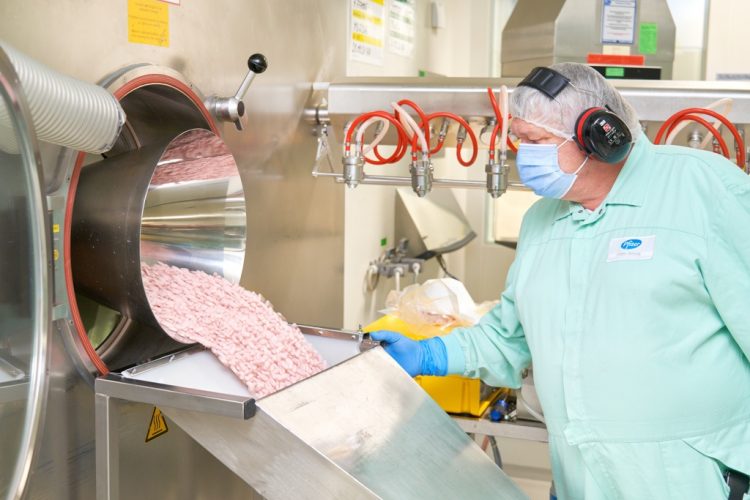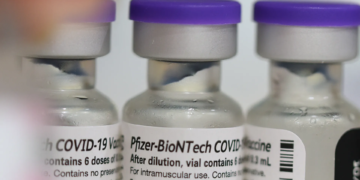Simple, easy and effective COVID-fighting pills are arriving in California’s pharmacies, offering hope as cases soar and immunity falls.
But the powerful new medicines – Pfizer’s Paxlovid and Merck’s molnupiravir – are in short supply, forcing physicians to make tough choices about who will most benefit from the treatment.
There’s a second challenge: The pills must be taken within five days of the start of symptoms when the virus is still reproducing. That means it’s important to find a test, pronto.
“Quick is the trick,” said San Jose’s Dr. Walter Newman, medical director for the United Farmworkers Union. This week, he prescribed the pills to two newly-infected patients who were at risk of severe COVID-19 due to age and diabetes.
As more than 100,000 Californians become infected every day, “we are inundated,” he said. “This will keep cases that are mild or moderate from progressing to severe illness and death.”
Dana Ludwig recognized that his sick 86-year-old brother-in-law, visiting from Huntington Beach, faced potential peril.
Within only three hours, doctors at UC San Francisco’s COVID-dedicated emergency room provided a PCR-confirmed diagnosis – and a prescription. Now, four days into treatment, his serious cough persists but his temperature has stabilized.
“He now has a better chance of surviving this thing,” said Ludwig, a data scientist who lives in Berkeley. “Even though he looked good, he could have dropped through the floor in a week.”
The U.S. Food and Drug Administration authorized the two drugs in late December – just as vaccinated Americans’ antibody levels were falling and the highly contagious omicron variant began to overtake delta.
Antiviral drugs are designed to transform life-threatening COVID-19 infections into a nuisance. Patients simply pick up the medicine at a drugstore, like any other prescription.
“We are currently challenged in treating COVID, due to the limited treatments we have available,” said Deepak Sisodiya, director of Pharmacy Services at Stanford Health Care. “And with oral therapies, patients don’t have to come in. They can be taken at home.”
By preventing severe illness, this approach “is a game-changer. It really helps protect our hospital resources,” said UCSF infectious disease expert Dr. Peter Chin-Hong.
Scientists stress that vaccines are still the best line of defense because they lower the risk of infection and impact if you do get sick. But to save the unvaccinated and those with “breakthrough” cases, they recognized they needed a drug that could help people who are already sick.
The pills are arriving at a time when some of the traditional tools to fight the virus – called monoclonal antibodies – are losing their effectiveness. Antivirals are easier to take than monoclonals because they don’t require an intravenous infusion.
And unlike vaccines or monoclonals, the drugs don’t create protective antibodies. Instead, they attack the virus itself.
Pfizer’s drug blocks an enzyme needed by the virus to reproduce. The Merck drug also stops viral replication, but in a different way. It’s based on a fake version of the virus’s genetic material; when the virus multiplies, it dies.
The results of clinical trials were heartening. The Pfizer drug cuts the risk of hospitalization or death in high-risk adults by 89%. The Merck drug is significantly less effective, reducing hospitalizations and deaths by 30%.
They work against all current variants. And while there is the risk of interaction with other drugs, there are few side effects.
Both drugs are given for five days. Pfizer’s three-tablet regimen is taken in the morning and night. Merck’s is four capsules, twice a day.
But there’s a shortage, so they’re only offered to people who meet all three of these criteria: positive test results, symptoms of mild to moderate COVID-19 illness and high risk for progressing to severe disease.
“The provider does the clinical assessment,” said Sisodiya. “When supply does not meet the demand, how do you make those tough choices? Our approach at Stanford has been very intentional. We (classify) patients, based on risk.”
The highest priority goes to people who are unvaccinated, partially vaccinated or vaccinated but immunocompromised due to illness or age, said doctors. Priority is also offered to those with cancer, cardiovascular disease, chronic kidney disease, chronic lung disease, diabetes, obesity, pregnancy and sickle cell disease.
“We all have patients that we would like to treat, but we just can’t, based on our supply,” said Katherine Yang, an infectious diseases pharmacist specialist at UCSF Health.
Why is there so little supply?
The mass production of small-molecule drugs is logistically complicated, according to medicinal chemist Derek Lowe in the journal Science. The drugs are produced from a large variety of chemicals, called reagents, that come from offshore suppliers, mostly in China. And production must be done on an industrial scale. For instance, the manufacture of 10 million courses of Paxlovid requires about 16.5 tons of material, he estimates.
“There’s a shortage of the stuff that’s used to make the stuff,” he wrote. “That’s how it goes in the fine chemical business – there’s a compound that no one really cares much about – until they do.”
Federal decision-making is also being blamed for the shortage. Early on, the U.S. didn’t place an order for the mass production of pills, like it did with vaccines, said Dr. Eric Topol, founder and director of the Scripps Research Translational Institute in La Jolla.
When the pill showed early promise, “Pfizer approached the administration to say ‘Would you like to put in big orders for Paxlovid?’” said Topol. Trusting in the power of vaccines, “it declined.”
The federal government is now working with companies to boost manufacturing. But it takes six to eight months to make Pfizer’s pill. Merck’s pill is easier to produce. The U.S. has bought enough Paxlovid to treat 20 million people; 10 million are now being distributed, with 4 million courses available by the end of January and another 10 million coming in June. It has committed to buying enough molnupiravir for 3.1 million people.
Distribution to states is based on population. This week, the federal government sent California 9,560 of its 99,960 courses of Paxlovid, and 38,480 of the 399,920 courses of molnupiravir.
Then California divvies it up among the counties, based on a different formula: equity and the number of cases. This means, for example, that hard-hit Riverside County is getting far more medicine than Marin.
So far, Bay Area counties have only gotten enough treatments for a few thousand patients.
Each county decides which of their hospitals, health centers and pharmacies get the medicine, and how much. Shipments come directly from Pfizer and Merck. But supply isn’t keeping up with demand, said UCSF’s Yang.
“It’s very dynamic. … Part of the difficulty for providers is trying to find a pharmacy that actually has it in stock,” she said. “We will take as much as we can get.”
Here is a look at the Bay Area’s current supply of coveted antiviral drugs that treat COVID-19:
- Santa Clara County: 200 of Paxlovid and 920 of molnupiravir;
- San Mateo County: 60 Paxlovid, 320 molnupiravir;
- Contra Costa County: 120 Paxlovid, no molnupiravir yet;
- Santa Cruz County: 20 Paxlovid, 280 molnupiravir;
- San Francisco County: 100 Paxlovid; 500 molnupiravir, of which 160 have been received;
- Alameda County did not provide data but said Paxlovid “is in high demand and scarce” and there is no molnupiravir yet
The state’s list of antiviral providers can be found here: https://www.cdph.ca.gov/Programs/CID/DCDC/Pages/COVID-19/Antiviral-Therapeutics.aspx. This does not guarantee availability.










:quality(70)/cloudfront-eu-central-1.images.arcpublishing.com/irishtimes/CGYPT6WE7VAO3KJ773SHUVMVBY.jpg?resize=1200,630&ssl=1)



